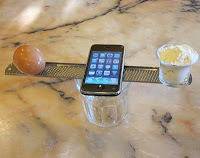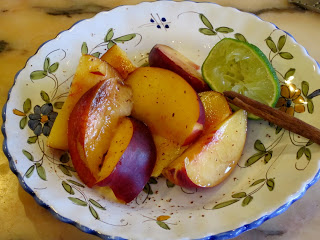Weight(y) Matters
/30 Comments/in Articles, Better Baking, Gluten Free baking, iPhone app, kitchen scales, weighing flour/by Alice MedrichMaybe it would take an iPhone app to get American home bakers to toss their measuring cups and start using a scale. If you want to skip my lecture on measuring (and why you should get a scale), just scroll down to see some iPhone apps (feel free to send your own photos). Meanwhile, ye faithful, read on…
First, when I say scale, I don’t mean a spring-loaded thing with a dial. I do mean a scale with batteries (like your smart phone, your iPod, your camera, and all of your other necessities). The scale should register eighths or tenths of an ounce. Such a scale can be had for less than the cost of ten lattes, btw. And, you can learn to use it in less time than it takes your barista to make those ten lattes.
If you bake (especially if you bake), here’s why you want a scale.
Consider flour. A heavy hand with flour is the prime suspect for bad baked goods. The amount of flour you put into your measuring cup can make the difference between a moist, light, poem of a cake and a doorstop. It can make the difference between buttery melt-in-your-mouth cookies (or fluffy pancakes) and miniature paperweights. What is a cup of flour anyway? If you stir the flour in your canister a little (but not to much) to loosen it, and then spoon it lightly into your measuring cup and sweep it level without packing, tapping, jiggling or shaking the cup, you’ll have 4 ¼ to 4 ½ ounces of flour in your cup. If you dip your cup into that same canister, and level it against the side, or shake it or tap it or jump up and down to level it, who knows how much flour you’ve got in there? And, if you measure right from the flour sack stored in the pantry jammed behind cans of beans or under the potatoes, then all bets are off. I asked a close friend to please measure a cup of flour at her house, as though she were preparing to bake a cake, and dump it into a bowl and bring it to me at my house. I put her cup of flour on my scale. It was 33% heavier than the lightly spooned and leveled cup described at the top of the paragraph. Can you tell me that a cake or cookies made with a 6-ounce cup of flour will come out remotely similar to those made with a 4 ½ -ounce cup?
Maybe you are living gluten free? Maybe you’ve wondered why you get great results from some recipes only some of the time? Gluten free baked goods are hypersensitive to measuring variation, and the non-wheat flours and starches (rice, corn, tapioca, oat, bean, potato, et al) are especially hard to measure consistently using measuring cups. To add insult to injury, if you make your own gluten free flour blend, the weight of 1 cup of your blend will depend on whether you measure it right after blending or weeks later after it has settled in the canister (that is, unless you make a point of really fluffing the mix before you measure each time). Masterful gluten free baking is challenging enough; using a scale eliminates one very significant wild card.
More reasons to use a scale? A scale streamlines your movements in the kitchen. You can measure ingredients right into the mixing bowl, so you’ll use fewer utensils and have less to clean up. A scale means never having to sift or chop before measuring, and never having to wonder how lightly or firmly to pack a cup of brown sugar. Some of the best chocolates don’t come in one once squares, so you need a scale. I could go on…
A scale means that your results for a given recipe will be more consistent from one time to the next, even (or especially!) if you bake that cake only once a year. If you are someone who is always tinkering and tweaking recipes—you probably make notes in the margin. Weighing is a better way to track your tweaks, especially small changes in critical ingredients such as flour.
Another* Nectarine Story
/5 Comments/in Articles, cinnamon stick, Food Memory, fruit, nectarines/by Alice MedrichRecipe: Slice ripe nectarines. Squeeze a little limejuice over the fruit. Toss very gently to keep the slices looking virginal. Serve on the hand-painted plates that you bought in Moustiers 20 years ago on a summer afternoon, after pedal boating in the Gorges du Tarn. Grate a little cinnamon stick over each plate.
The old author as new blogger
/30 Comments/in Articles, creative process, Malcolm Gladwell, npr, recipe testing, Terry Gross/by Alice MedrichWhat a surprise to learn that starting a blog is more intimidating than writing a book. It’s immediate. Where is the editor to prevent one from making a fool of oneself or committing atrocious grammar? The spontaneity goes against my nature, which is to write (or test) and rewrite (or retest) and rewrite and retest again. To ease into it, I planned a little essay on the creative process. I love to hear any artist (writer, painter, dancer, musician, chef) discuss their work. Even the most mundane details of how they actually do the work has a voyeuristic fascination for me. National Public Radio is a staple in my kitchen. I love Terry Gross and City Arts and Lectures. I planned to cite Malcom Gladwell’s descriptions of artists and their work styles from his New Yorker piece, “Late Bloomers”.
But by the time I sat down to write that essay, I was overcome by my own process. All kitchen counters and the dining room table were covered with labeled samples. The actual work area was a landscape of drips, greasy spatulas, and bowls full of goop flanked by clipboards with handwritten notes coded to match (I hope) the labeled samples. I start a clipboard at the beginning of each project (book, magazine article, client) and after a while I move pages from the clipboard into a binder so I can put tabs on groups of pages to keep some order. I try to remember to date every page and I put the most recent page on top, like a legal brief. I used to be able to have three or four clipboards in play at one time. But lately not so much. After scribbling tasting notes on the wrong clipboard a few times, I refined my process. Now it’s one or possibly two clipboards at a time, and NPR stays on.
I have a reputation for testing. A lot. Anyone who has read or cooked from my books, Bittersweet or Pure Dessert knows this. I thought I was normal until Dianne Jacob described my testing mania in her book, Will Write for Food (a wonderful manual for budding food and cookbook writers, btw). Then I felt self-conscious. But, some times multiple trials are necessary to get flavor, texture, and visuals of a dessert right to begin with. Other times I retest because I’m stubborn or curious. Even when I like my results, I catch myself wondering what would happen if I made this little change, or that one. I love how small details make a difference. “What if this, what if that” is the hallmark of my process and perhaps my greatest professional and artistic asset and also my biggest liability. If I take more time on a recipe than I think I should, I figure it’s an investment for a future project. You can imagine where that leads…
Welcome to my blog, I promise recipes and photos (and shorter posts) in future, but meanwhile check out Malcolm Gladwell’s “Late Bloomers” to find out if you are more like Picasso or more like Matisse. http://www.newyorker.com/reporting/2008/10/20/081020fa_fact_gladwell?printable=true.




